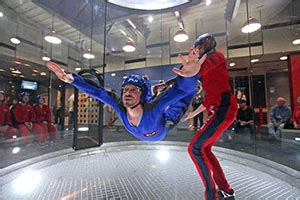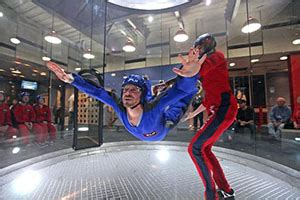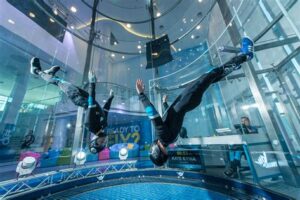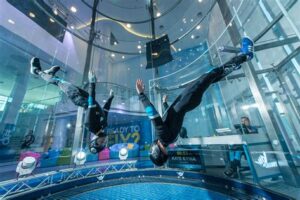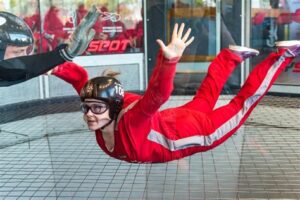Table of Contents
An indoor skydiver is a person who participates in the thrilling sport of indoor skydiving, also known as vertical wind tunnel flying. This exhilarating activity allows individuals to experience the sensation of freefalling without the need for an airplane or parachute. Indoor skydivers can perform various acrobatic maneuvers and hone their skills in a controlled environment, making it a popular choice for both beginners and experienced skydivers.
Are you ready to experience the thrill of skydiving without ever leaving the ground? Look no further than indoor skydiving! Whether you’re a seasoned adrenaline junkie or someone who simply wants to try something new and exciting, indoor skydiving is an exhilarating adventure that will leave you breathless. Step into a wind tunnel, feel the rush of air against your body, and defy gravity as you float effortlessly in the air. In this paragraph, we will guide you through the entire process of indoor skydiving, from the preparation to the actual flight, ensuring that you have the most incredible and unforgettable experience possible.
Introduction
Welcome to the world of indoor skydiving, where the thrill of soaring through the air meets the safety and comfort of an enclosed environment. Indoor skydiving, also known as vertical wind tunnel flying, has become a popular recreational activity for thrill-seekers of all ages. In this article, we will guide you through the exhilarating experience of being an indoor skydiver and provide step-by-step instructions on how to make the most of your flight.
Gearing Up
Choosing the Right Gear
Before you take flight, it’s essential to equip yourself with the proper gear. Most indoor skydiving facilities provide you with a jumpsuit, helmet, goggles, and earplugs. Make sure these items fit you comfortably to ensure a safe and enjoyable experience.
Understanding Body Positioning
Body positioning is crucial in indoor skydiving. The key is to maintain a stable and balanced posture throughout your flight. Arch your back slightly, extend your arms forward, and keep your legs straight while pointing your toes. This position will help you achieve optimal stability and control.
Preparing for Takeoff
Listening to the Instructor
Prior to entering the wind tunnel, you will receive a thorough briefing from your instructor. Pay close attention to their instructions on body positioning, hand signals, and safety protocols. It’s crucial to listen carefully to ensure a safe and enjoyable flight.
Mastering Hand Signals
During your flight, communication with your instructor is essential. They will guide you using a series of hand signals, allowing you to adjust your body position and improve your skills. Familiarize yourself with these signals, such as thumbs up for straightening your legs or thumbs down for bending them, to make the most of your time in the wind tunnel.
Enjoying the Flight
Feeling the Rush
As you enter the wind tunnel and the powerful air currents lift you off the ground, prepare yourself for an unforgettable rush of adrenaline. The feeling of weightlessness combined with the sensation of flying is truly exhilarating. Embrace the freedom and enjoy every moment of your flight.
Experimenting with Movements
Once you’ve become comfortable with the basic body position, don’t be afraid to experiment with different movements. Try small adjustments to your arms, legs, and head to feel the effects of slight changes in airflow. This experimentation will help you develop better control and coordination as an indoor skydiver.
Post-Flight Tips
Celebrating Your Achievement
After your flight, take a moment to celebrate your achievement. Indoor skydiving is an incredible feat that not everyone gets to experience. Share your excitement with friends and family, and savor the memories of your thrilling adventure.
Reflecting and Improving
Indoor skydiving is a skill that can always be improved upon. Take some time to reflect on your flight – what went well and what you can work on. Consider taking additional sessions or advanced training to enhance your abilities and push your limits further.
Conclusion
Indoor skydiving offers an extraordinary opportunity to fulfill your skydiving dreams in a controlled and safe environment. By following these instructions and tips, you can make the most of your indoor skydiving experience. So gear up, prepare for takeoff, enjoy the flight, and let the wind beneath your wings carry you to new heights!
Safety Precautions:
Before attempting indoor skydiving, it is important to go through a safety briefing where a trained instructor will explain the necessary precautions and safety measures. Ensure that you understand and follow all instructions provided before getting inside the wind tunnel.
Entering the Wind Tunnel:
Approach the wind tunnel entrance carefully and follow the instructions of the instructor. Make sure you have the appropriate gear, such as a jumpsuit, helmet, and goggles. Maintain a calm and focused demeanor as you step into the wind tunnel.
Body Positioning and Stability:
Once inside the wind tunnel, maintain a stable body position with your arms stretched out to the sides and your legs slightly bent. Keep your head up and your eyes forward. The instructor will guide you on how to maintain stability while flying.
Learning Basic Maneuvers:
As you gain confidence and become comfortable in the wind tunnel, the instructor will introduce you to basic maneuvers. Follow their guidance on how to control your body movements to turn, change altitude, and perform other aerial maneuvers.
Flying Techniques:
To maximize your experience as an indoor skydiver, the instructor will teach you various flying techniques. These may include the Superman position, belly flying, back flying, and vertical flying. Follow the step-by-step instructions provided to execute these techniques safely.
Communicating with the Instructor:
During your indoor skydiving session, it is essential to maintain effective communication with your instructor. Listen carefully to their instructions and ask questions if anything is unclear. Follow prompts given by the instructor to make adjustments to your body position or movements.
Exiting the Wind Tunnel:
As your session comes to an end, the instructor will guide you on exiting the wind tunnel safely. Follow their instructions to ensure a smooth departure. Remove any gear, such as the jumpsuit, helmet, or goggles, before leaving the designated area.
Review and Follow Up:
After your indoor skydiving experience, take some time to review what you have learned with the instructor. Ask for feedback on your performance and techniques. Practice and refine your skills based on their recommendations for future sessions.
Remember, indoor skydiving can be an exhilarating and exciting experience, but it is crucial to pay attention to safety guidelines and follow the instructions provided by the trained instructors at all times.
Point of View: Indoor Skydiver Use Instructions Voice and Tone
When it comes to providing instructions for using an indoor skydiver, it is crucial to adopt a clear and concise voice that instills confidence in the users. The tone should be authoritative yet friendly, empowering individuals with the knowledge they need to safely enjoy the experience. Here are some key points regarding the voice and tone for indoor skydiver use instructions:
- Clarity: The instructions should be written in a straightforward manner, using simple and easily understandable language. Avoid technical jargon or complex terminology that might confuse users.
- Encouragement: The tone should be positive and encouraging, emphasizing the fun and exhilarating aspects of indoor skydiving. Use phrases such as Get ready for an incredible adventure! or Feel the rush of freefall in a controlled environment! to create excitement and anticipation.
- Authority: It is important to establish credibility and expertise in the instructions. Use a confident and knowledgeable tone to assure users that they are in capable hands. Phrases like Our team of experts has designed this experience with your safety in mind or Follow these instructions carefully for a safe and enjoyable flight can help establish trust.
- Conciseness: Avoid lengthy explanations and unnecessary details. Keep the instructions concise and to the point, focusing on the essential steps and safety precautions. Bullet points or numbered lists can help organize the information and make it easier to follow.
- Reassurance: Acknowledge any potential concerns or fears that users may have and provide reassurance throughout the instructions. Let them know that their safety is a top priority and that trained professionals will be available to guide them through the process.
- Friendliness: Although the tone should be authoritative, it is also essential to maintain a friendly and approachable demeanor. Use inclusive language and avoid sounding overly stern. Phrases like We’re here to help you every step of the way or Don’t worry, it’s easier than it looks! can help create a warm and welcoming atmosphere.
By adopting a clear, encouraging, and authoritative voice with a friendly tone, the indoor skydiver use instructions can effectively guide users through the process while instilling confidence and excitement. Remember to tailor the instructions to the target audience, ensuring that they are accessible to individuals of all skill levels and backgrounds.
Thank you for visiting our blog and taking the time to learn about the thrilling world of indoor skydiving. We hope that this article has provided you with valuable instructions and insights into this exhilarating sport. Whether you are a seasoned skydiver or someone who is curious about trying it for the first time, indoor skydiving offers a unique and accessible way to experience the thrill of freefall without the need to jump from a plane.
Indoor skydiving, also known as bodyflight, is a captivating activity that simulates the sensation of freefall using a vertical wind tunnel. These state-of-the-art facilities generate powerful updrafts of air that allow participants to float and fly in a controlled environment. The experience of defying gravity and soaring through the air is truly awe-inspiring, and indoor skydiving provides an opportunity for people of all ages and abilities to enjoy the excitement of flight.
If you are new to indoor skydiving, we encourage you to give it a try. The sport is suitable for individuals of all fitness levels and does not require any previous experience. Professional instructors will guide you through the entire process, ensuring your safety and providing you with the necessary skills to enjoy your flight. Whether you are interested in a one-time experience or you want to pursue it as a hobby, indoor skydiving offers an adrenaline rush like no other.
Indoor skydiving is not only a thrilling adventure but also a great way to stay fit and improve your physical health. The intense wind resistance forces your body to work harder, engaging your core muscles and promoting balance and stability. Additionally, the mental focus required during flight enhances concentration and mindfulness. So, if you are looking for a fun and unique way to exercise both your body and mind, indoor skydiving is the perfect activity for you.
In conclusion, we hope that this article has inspired you to explore the world of indoor skydiving. Whether you are seeking an unforgettable experience, a new hobby, or a way to stay fit, indoor skydiving offers it all. So why wait? Take the leap and embark on an incredible journey of flight and freedom! We look forward to seeing you at one of the many indoor skydiving facilities around the world.
Video Indoor Skydiver
People also ask about Indoor Skydiving:
-
What is indoor skydiving?
-
How does indoor skydiving work?
-
Is indoor skydiving safe?
-
Do you need any prior experience to try indoor skydiving?
-
What should I wear for indoor skydiving?
Indoor skydiving is a simulated skydiving experience that takes place in a vertical wind tunnel. It allows individuals to experience the sensation of freefalling without actually jumping out of an airplane.
Indoor skydiving works by using a powerful vertical wind tunnel that generates a controlled upward airflow. Participants wear specialized flight suits and enter the wind tunnel, where the strong winds keep them suspended in mid-air, creating a simulated freefall experience.
Yes, indoor skydiving is generally considered safe. The vertical wind tunnels used in indoor skydiving are designed with safety in mind, and trained instructors are always present to guide participants and ensure their well-being throughout the experience.
No prior experience is required to try indoor skydiving. It is suitable for people of all ages and fitness levels. Before the flight, participants receive a briefing from the instructors to learn the necessary techniques and safety procedures.
It is recommended to wear comfortable, athletic clothing such as a t-shirt, shorts or leggings, and sneakers. Loose jewelry, accessories, and items that may fly off during the flight should be removed. Flight suits and helmets are provided by the facility.

